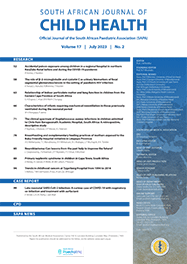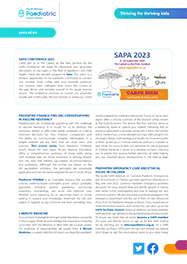Adherence to phototherapy guidelines in term neonates: Study at a private tertiary-level neonatal unit
1 School of Medical Science and Research, and Sharda Hospital, Sharda University, Greater Noida, Uttar Pradesh, India
2 Department of Paediatrics, Pusphanjali Crosslay Hospital, Ghaziabad, Uttar Pradesh, India
Corresponding
author: T Ekram
(tarique2k3@yahoo.co.in)
Guidelines for starting phototherapy for neonatal jaundice in term neonates have been published by the American Academy of Pediatrics (AAP) and others, such as the National Institute for Health and Clinical Excellence (NICE), but the practical implementation of such guidelines and factors associated with possible non-adherence have not been studied. We report our experience at a self-paying tertiary-care hospital. Of the 155 term babies given phototherapy in our hospital between August 2012 and August 2013, 65 (41.9%) babies were found to have received phototherapy at serum bilirubin values lower than recommended AAP guidelines. Factors found responsible for non-adherence to guidelines were: (i) parents’ request for early discharge, with unwillingness to come the next day for follow-up despite borderline serum bilirubin level noted in 25 (38.5%); (ii) clinical assessment of bilirubin was higher than reported laboratory value in 16 (24.6%); and (iii) babies were given phototherapy as parents had been counselled regarding the need for phototherapy by a referring paediatrician in 12 (18.5%).
S Afr J CH
2015;9(1):22. DOI:10.7196/SAJCH.714
Guidelines for giving phototherapy for jaundice in babies born
beyond 35 weeks of gestation have been published by various
organisations, including the American Academy of Pediatrics
(AAP)1
and others, such as the National Institute for Health and
Clinical Excellence (NICE).2 The practical implementation
of such guidelines and factors associated with possible
non-adherence have not been studied, especially in self-paying
tertiary-care centres of the developing world, such as India. This prompted us to review our data
concerning adherence to published phototherapy guidelines, and
to determine the reasons, if any, for non-adherence.
Methods
In this retrospective study, the case records of neonates
admitted between August 2012 and August 2013 in a self-paying,
tertiary-level neonatal intensive care unit (NICU) of northern
India were reviewed. The following were recorded: baby’s and
mother’s blood group, gestational age, serum bilirubin level
with age in hours, duration of phototherapy, risk factors
associated with hyperbilirubinaemia, e.g. history of birth
asphyxia,1 glucose-6-phosphate
dehydrogenase (G6PD) status, thyroid profile and sepsis screen
(if done). The study protocol received institutional ethics
committee approval. Data were analysed using statistical
software SPSS version 17 (IBM, USA).
Results
Of 571 admissions, 319 were term babies (including 3
babies who required an exchange transfusion), and
155 infants received phototherapy. Only 90/155 (58.1%)
received phototherapy according to the AAP 2004 guidelines
(Table 1).1 In
65 (41.9%) babies, phototherapy was initiated
below the recommended serum bilirubin level. In 25/65 (38.5%),
phototherapy was initiated because the parents insisted on
early discharge and were unlikely to be available for further
follow-up. In 12 (18.4%), early phototherapy was initiated
because a local paediatrician had referred the
baby after counselling. In 16 (24.6%), clinical assessment of
serum bilirubin was considered to be higher than
was reported by the laboratory, and among these, 10 babies had
risk factors for hyperbilirubinaemia and received phototherapy
as a precautionary measure. The median duration of
phototherapy was 36 hours in the case of those
babies who received phototherapy according to the guidelines,
and 24 hours in the case of babies receiving phototherapy
below the recommended bilirubin level.
Discussion
In this study, we found that the guidelines for starting
phototherapy in term neonates were ignored in more than 40% of
babies in this particular hospital. Early intended discharge
with reluctance to return for follow-up (most common reason),
inappropriate counselling by a referring
paediatrician, and discordance between laboratory value and
clinical assessment were the key factors that led to
non-adherence to available guidelines for the initiation of
phototherapy. As phototherapy causes disruption of
mother-and-baby bonding and also has cost implications, its
empirical use should be minimised. Babies with
high-risk factors have more chances of receiving phototherapy
despite having a bilirubin level below the recommended level.
Conclusion
Phototherapy guidelines are not always adhered to. Similar studies from other centres are required in order to confirm reasons for non-adherence and to minimise deviation from guidelines.
References
1. American Academy of Pediatrics Subcommittee on Hyperbilirubinemia. Management of hyperbilirubinemia in the newborn infant 35 or more weeks of gestation. Pediatrics 2004;114(1):297-316. [http://dx.doi.org/10.1542/peds.114.1.297]
2. National Collaborating Centre for Women’s and Children’s Health, for the National Institute for Health and Clinical Excellence (NICE). Neonatal jaundice: Clinical guidelines. London: Royal College of Obstetricians and Gynaecologists, 2010.
Article Views
Full text views: 3737

.jpg)



Comments on this article
*Read our policy for posting comments here